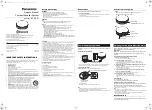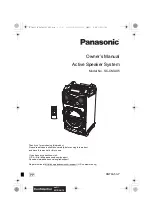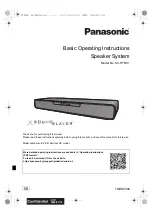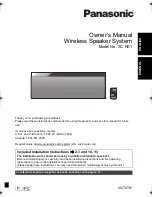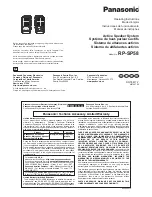
6
INST APD0601 A140513 Wireless Smoke Heat Alarm Install Guide
•
In or below a cupboard
•
Where air flow would be obstructed by curtains or furniture
•
Where dirt or dust could collect and block the sensor
•
Where it could be knocked, damaged, or inadvertently removed
This detector shall not be installed in location where the normal ambient
temperature is below 40°F (4.4°C) or where it exceeds 100°F (37.8°C).
THIS EQUIPMENT SHOULD BE INSTALLED IN ACCORDANCE WITH
NFPA 72: NATIONAL FIRE ALARM AND SIGNALING CODE.
MOUNTING THE DETECTOR
Note:
These alarm devices should only be installed by a competent
engineer/technician.
This device should not be used with a guard.
Once a suitable location is found, mount the detector as follows:
1. Refer to the diagram below and install the mounting base on the
ceiling or on the wall (if local ordinances permit) using screw
locations as required. Use the two screws and anchors provided.
Maneuver the base so the screws are at the elbow of the screw
slots and secure.
2. Fit the detector inside the base by aligning it over the base as
shown (detector’s alignment notch should be slightly offset from
mounting base tamper release tab), then turn the detector in a
clockwise direction until it clicks into place.
3. Test the detector after completing the installation (as described
in the TESTING THE DETECTOR section of this manual) and refer
to the control system’s instructions for additional information
concerning the use of wireless devices.
2
3
the compartment. If the batteries are incorrectly inserted please remove
gently with a non-conductive tool and correctly reinsert.
4. Reinstall the detector onto the mounting base by turning the detector
clockwise until the mating marks align.
5. After the power-up sequence the green LED should blink about once
every 12 seconds to indicate normal operation. If the batteries are not
installed correctly, the detector will not operate and the batteries may be
damaged. If the detector does not power-up, check for correct batteries
installation and for a fully charged batteries
6. Test the detector (as described later).
CONSTANT EXPOSURES TO HIGH OR LOW TEMPERATURES OR
HIGH HUMIDITY MAY REDUCE BATTERY LIFE.
PROGRAMMIN
G
Refer to the appropiate
compatible
control panel programming guide for
the proper procedure required to enroll the wireless smoke/heat into the
system.
RECOMMENDED LOCATIONS FOR SMOKE HEAT ALARM
According to National Fire Protection Association (NFPA) the major
threat from fi re in a dwelling unit occurs at night when everyone is asleep.
The principal threat to persons in sleeping areas comes from fi res in
the remainder of the unit; therefore, a smoke detector(s) is best located
between the bedroom areas and the rest of the unit. In units with only one
bedroom area on one fl oor, the smoke detector(s) should be located as
shown in Figure 2. In dwelling units with more than one bedroom area or
with bedrooms on more than one fl oor, more than one smoke detector is
required, as shown in Figure 3.
In addition to smoke detectors outside of the sleeping areas, the device
should be installed on each additional story of the dwelling unit, including
the basement. These installations are shown in Figure 4. The living area
smoke detector should be installed in the living room or near the stairway
to the upper level, or in both locations. The basement smoke detector
should be installed in close proximity to the stairway leading to the fl oor
above. Where installed on an open-joisted ceiling, the detector should
be placed on the bottom of the joists. The detector should be positioned
relative to the stairway so as to intercept smoke coming from a fi re in the
basement before the smoke enters the stairway.
Smoke detectors are optional where a door is not provided between living
room and recreation room (Figure 5).
The smoke from a fi re generally rises to the ceiling, spreads out across
the ceiling surface, and begins to bank down from the ceiling. The corner
where the ceiling and wall meet is an air space into which the smoke could
have diffi culty penetrating. In most fi res, this dead air space measures
about 0.1m (4in.) along the ceiling from the corner and about 0.1m (4in.)
down the wall.
Detectors should not be placed in this dead air space, see
Figure 6,7 and 8.
Where NOT to install the alarm:
- Directly above a sink, cooker, stove or oven
- Do not locate detector within 5 feet (1.5 m) of any cooking appliance
- Next to a door or window that would be affected by drafts i.e. extractor fan
or air vent
- Outside
- Do not install in any environment that does not comply with the detector’s
environmental specifi cations
Chambre
Salon
Salle de jeux
Chambre
Cave
I
Installation optionnelle d’un détecteur de fumée s'il
n'y a pas de porte entre le salon et la salle de jeux
Installation d’un détecteur de fumée requise
Entrée
Salle à
manger
Cuisine Chambre Chambre
Chambre
Salon
TV
room
Cuisine
Salon
Chambre
Chambre
Chambre
Chambre
Salon
Salle à
manger
Cave
Entrée
Chambre
Plafond
Installation acceptable ici
Ne jamais l’installer ici
Installation de la partie
supérieure du détecteur
acceptable ici
Paroi latérale
100 mm (4 in.)
100-mm
(4-in.)
minimum
300-mm
(12-in.)
maximum
Remarque : les mesures
indiquées sont à l’angle
le plus proche du détecteur.
Installation
recommandée
partout dans
cette zone
Installation interdite
dans cette zone
900 mm
(36 in.)
900 mm
(36 in.)
102 mm
(4 in.)
900 mm (3 ft)
102 mm (4 in.)
Pas dans cette zone
N’importe où
dans cette zone
Fig 5.
Installation dans une maison
à demi-niveaux
Fig 2.
Emplacement des détecteurs
dans des maisons ayant une seule
chambre à coucher sur un étage
Fig 3.
Emplacement des détecteurs
dans des maisons de plus d'une
chambre à coucher ou ayant des
chambres sur plus d'un étage
Fig 4.
Un détecteur installé à chaque étage
Fig 6.
Exemple d’installation appropriée des détecteurs
Fig 8.
Exemple d’installation appropriée
de détecteurs sur des plafonds en relief
Fig 7.
Exemple d’installation appropriée des détecteurs sur un plafond incliné
recommended for verifying system protection capability.
Direct Heat Method (Hair dryer of 1000-1500 watts)
Direct the heat toward the thermistor. Be sure to hold the heat source about
12 inches from the detector to avoid damage to the plastic. The detector will
reset only after it has time to cool.
A detector that fails to activate with any of these tests should fi rst be
cleaned as outlined in this manual’s MAINTENANCE section. If the detector
still fails to activate, return for repair.
MAINTENANCE
TEST ONCE A WEEK.
WARNING! USE ONLY BATTERIES SPECIFIED. USE OF DIFFERENT
BATTERIES MAY HAVE A DETRIMENTAL EFFECT ON THE SMOKE
ALARM.
YOUR ALARM SHOULD BE CLEANED AT LEAST ONCE A YEAR.
To clean your alarm, remove it from the mounting base. You can clean the
interior of your alarm by using compressed air or vacuum cleaner hose and
blowing or vacuuming through the openings around the perimeter of the
alarm. The outside of the alarm can be wiped with a damp cloth.
After cleaning, reinstall and test your alarm by using the test button. If
cleaning does not restore the alarm to normal operation the alarm should
be replaced.
WARNING: PLEASE READ CAREFULLY AND THOROUGHLY
• NFPA 72 states: Fire-warning equipment for residential occupancies are
capable of protecting about half of the occupants in potentially fatal fi res.
Victims are often intimate with the fi re, too old or too young, or physically or
mentally impaired such that they cannot escape even when warned early
enough that escape should be possible. For these people, other strategies
such as protection-in-place or assisted escape or rescue would be neces-
sary.
• A battery powered alarm must have a battery of the specifi ed type, in
good condition and installed properly.
• Smoke alarms must be tested regularly to make sure the batteries and the
alarm circuits are in good operating condition.
• Smoke alarms cannot provide an alarm if smoke does not reach the
detector. Therefore, smoke alarms may not sense fi res starting in chimneys,
walls, on roofs, on the other side of a closed door or on a different fl oor
• If the alarm is located outside the sleeping room or on a different fl oor, it
may not wake up a sound sleeper.
• Studies have shown that smoke and heat alarms may not awaken all
sleeping individuals, and that it is the responsibility of individuals in the
household that are capable of assisting others to provide assistance to
those who may not be awakened by the alarm sound or those who may be
incapable of safely evacuating the area unassisted.
• The use of alcohol or drugs may also impair one’s ability to hear the
smoke alarm. For maximum protection, a smoke alarm should be installed
in each sleeping area on every level of a home.
• Although smoke alarms can help save lives by providing an early warning
of a fi re, they are not a substitute for an insurance policy. Home owners and
renters should have adequate insurance to protect their properties.
FAMILY ESCAPE PLAN
According to National Fire Protection Association (NFPA) there often is very
little time between the detection of a fi re and the time it becomes deadly.
This interval can be as little as 1 or 2 minutes. Planning and practicing for
fi re conditions with a focus on rapid exit from the residence are important.
Drills should be held so that all family members know the action to be
taken.
SAFETY TIPS
• Make a home escape plan. Draw a map of your home showing all doors
and windows. Discuss the plan with everyone in your home.
• Know at least two ways out of every room, if possible. Make sure all doors
and windows leading outside open easily.
• Have an outside meeting place (like a tree, light pole or mailbox) a safe
distance from the home where everyone should meet.
• Practice your home fi re drill at night and during the day with everyone in
your home, twice a year.
• Practice using different ways out.
• Teach children how to escape on their own in case you can’t help them.
• Close doors behind you as you leave.
TESTING THE DETECTOR
NOTE: Before testing, notify the central station that the detector system is
undergoing maintenance in order to prevent unwanted alarms. Testing the
detector will activate an alarm and send a signal to the panel. Also, the test
function cannot be used if the detector has a trouble condition.
Detectors must be tested after installation and following periodic mainte-
nance.
Testing Detector Operation
This test checks the detector’s sounder, LEDs, and transmitter.
1. The test button is located on the detector housing.
2. Push and hold the test button for a minimum of 5 seconds. The alarm
panel will trigger and then the detector will go into alarm. The sounder
begins the temporal 3 pattern and the red LED blinks. The alarm panel’s
console should display the detector’s name in alarm.
Smoke Test
Hold a smoldering punk stick or cotton wick at the side of the detector
and gently blow smoke through the detector until the unit alarms. Canned
smoke aerosol is also an acceptable method. Smoke detection testing is
- In or below a cupboard
- Where air fl ow would be obstructed by curtains or furniture
- Where dirt or dust could collect and block the sensor
- Where it could be knocked, damaged, or inadvertently removed
This detector shall not be installed in location where the normal ambient
temperature is below 40°F (4.4°C) or where it exceeds 100°F (37.8°C).
THIS EQUIPMENT SHOULD BE INSTALLED IN ACCORDANCE WITH
NFPA 72: NATIONAL FIRE ALARM AND SIGNALING CODE
.
MOUNTING THE DETECTOR
Note:
These alarm devices should only be installed by a competent engi-
neer
/technician
.
This device should not be used with a guard.
Once a suitable location is found, mount the detector as follows:
1. Refer to the diagram below and install the mounting base on the ceiling
or on the wall (if local ordinances permit) using screw locations as required.
Use the two screws and anchors provided. Maneuver the base so the
screws are at the elbow of the screw slots and secure.
2. Fit the detector inside the base by aligning it over the base as shown
(detector’s alignment notch should be slightly offset from mounting base
tamper release tab), then turn the detector in a clockwise direction until it
clicks into place.
3. Test the detector after completing the installation (as described in the
TESTING THE DETECTOR
section of this manual) and refer to the control
system’s instructions for additional information concerning the use of wire-
less devices.
Ne pas fixer le détecteur sur des panneaux de plafond amobibles
100 mm (4 in.) minimum
100 mm (4 in.)
minimum
Fig 9.
Installation du détecteur
INST APD0601 A140513
INST APD0601 A140513
Salle à
manger

























